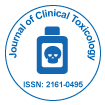
Journal of Clinical Toxicology
Open Access
ISSN: 2161-0495

ISSN: 2161-0495
K S Tilak
Scientific Tracks Abstracts: J Clin Toxicol
Genotoxicity is the property possessed by organisms and due to various carcinogens in which some are mutagens causing defects
even in natal stage. The effects are attempted in two modes acute or chronic, resulting the products of oxidative damage
especially in human urine and finally reflect the overall damage to all tissues and organs in the body. The chronic levels manifest
changes in biochemical parameters and such sub-lethal effects at biochemical level viz: acetylcholinesterases (ACh), superoxide
dismutase (SOD), catalase (CAT), glutathione peroxidase (GPx), glutathione-s-transferase (GSH), alkaline phosphatase (ALP),
aminotransferases (SGOT & SGPT), and malonialdehyde (MDA). Erythrocyte AChE was significantly decreased in farmer/sprayers
at the instant of exposure and the decrement recorded as 45% and 36% respectively in RBC and plasma. A sampling data were
analyzed as three separate, target, exposed and control groups characterized by time scale exposure differing in age and smoking
habits, symptomatic and asymptomatic group consisting of nicotinic and muscarinic class and finally methylated and ethylated op
and mixed also. Similary SOD, CAT, GPx, Transaminase’s ALP lipid per oxidation and GSH activities resulted different changes in
the pesticide exposed exposure. The studies of genotoxicity in humans reflect the influence of the body’s metabolic activation and
detoxification systems. Comets form as the broken ends of the negatively charged DNA molecule become free to migrate in the
electric environment towards the anode. Micronuclei are formed when acentric chromatid or chromosomal fragments, fail to migrate
towards the spindle poles, and are not incorporated into the daughter nuclei. 8-hydroxydeoxyguanosine is a ubiquitous marker of
oxidative stress and is an oxidatively modified guanosine which is also mostly frequently detected DNA lesion in urine. The pesticide
exposed workers had higher levels of DNA by tail DNA as percentage, Olive Tail Movement (OTM) and tail length and age group; the
exposed workers had significantly more DNA damage. The micronucleus (MN) analysis showed significantly higher MN induction in
the smokers both in the control as well as in the exposed group resulting higher frequencies. The increased urinary levels of 8-OHdG
were contributed by both non-smokers as well as smokers in the exposed groups.
K S Tilak is a Doctorate from Andhra University, Waltair, AP, India, the former Dean of faculty of Natural Sciences, Chairman Board of Studies (PG) Zoology and Head of
the Department of Zoology and Aquaculture having 40 years of research experience in the field of “Aquatic Toxicology”, having guided 29 research degrees, published 72
research papers in international and national journals recipient of prestigious ‘Archana Gold Medal’ by Academy of Environmental Biology, editor and reviewer of reputed
journals, attended and conducted international and national conference in Acharya Nagarjuna University, India.